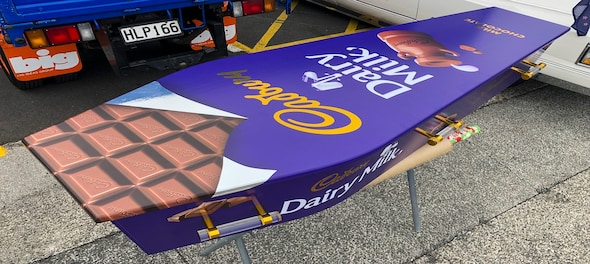
Two of the sweetest multinational brands in India, once slugged it out in international courts over the colour purple. At the heart of the dispute between chocolate giants Cadbury and Nestle was the ubiquitous packaging used by Cadbury, in which Pantone 2685C, a shade of Purple which it had started using in 1995, was a central figure.
All went well till 2004 when Cadbury decided to trademark that particular shade on the basis of “acquired distinctiveness” and filed an application to that effect with the UK Trademark Office. Its end objective was to extend the distinctive packaging to other products like “chocolate confectionery, chocolate assortments, cocoa-based beverages, preparations for cocoa-based beverages, chocolate-based beverages, preparations for chocolate-based beverages, chocolate cakes,” etc.
Predictably Nestle contested the application on various grounds including bad faith and lack of distinctiveness. Cadbury’s argument was that it had been using the colour in its packaging ever since it had decided to honour the choice of Queen Victoria in 1914.
The case dragged on for the next seven years till in 2011 a UK Intellectual Property Office hearing decided that since the colour was closely associated by people with Cadbury’s milk chocolates, the company was entitled to register a trademark for the same. Nestle took the case to a UK High Court but here too it was dismissed though in a concession to Nestle the court ruled that the judgement wouldn’t apply to Cadbury’s dark or white chocolates.
It wasn’t the first such reverse for Cadbury. In April 2006, three years after Cadbury had launched legal proceedings against Australian confectioner Darrell Lea over its use of various shades of purple in its store signage, uniforms and product packaging, Australia's Federal Court ruled that the company did not "own" the colour purple.
The case had little bearing on the market in India with Cadbury, which first set up shop in the country in 1948, continuing to hold sway with a 55 percent share of the market as against Nestle’s slimmer 15 share. Since then Cadbury has further strengthened its position in the $1.9 billion Indian chocolate market as of 2020. Now operating as Mondelez India, it has a 65 percent share of the chocolate confectionery segment, followed by Nestle at around 20 percent.
All went well till 2004 when Cadbury decided to trademark that particular shade on the basis of “acquired distinctiveness” and filed an application to that effect with the UK Trademark Office. Its end objective was to extend the distinctive packaging to other products like “chocolate confectionery, chocolate assortments, cocoa-based beverages, preparations for cocoa-based beverages, chocolate-based beverages, preparations for chocolate-based beverages, chocolate cakes,” etc.
Predictably Nestle contested the application on various grounds including bad faith and lack of distinctiveness. Cadbury’s argument was that it had been using the colour in its packaging ever since it had decided to honour the choice of Queen Victoria in 1914.
The case dragged on for the next seven years till in 2011 a UK Intellectual Property Office hearing decided that since the colour was closely associated by people with Cadbury’s milk chocolates, the company was entitled to register a trademark for the same. Nestle took the case to a UK High Court but here too it was dismissed though in a concession to Nestle the court ruled that the judgement wouldn’t apply to Cadbury’s dark or white chocolates.
Cadbury’s defining milk chocolate, the popular Cadbury Dairy Milk, had been launched in 1905 though its founder John Cadbury had started with a solid chocolate bar in Birmingham as far back as 1849. Given its lineage, the UK-based company, now owned by Mondelez International, might have been fine with the ruling but its rival Nestle wasn’t having any of it. The Swiss company challenged the judgement and in October 2013 a UK Court of Appeals ruled in its favour and Cadbury lost its trademark of the purple colour. The next year its right to appeal was rejected by the courts and with that Pantone 2685C was no longer the sole preserve of Cadbury.
It wasn’t the first such reverse for Cadbury. In April 2006, three years after Cadbury had launched legal proceedings against Australian confectioner Darrell Lea over its use of various shades of purple in its store signage, uniforms and product packaging, Australia's Federal Court ruled that the company did not "own" the colour purple.
The case had little bearing on the market in India with Cadbury, which first set up shop in the country in 1948, continuing to hold sway with a 55 percent share of the market as against Nestle’s slimmer 15 share. Since then Cadbury has further strengthened its position in the $1.9 billion Indian chocolate market as of 2020. Now operating as Mondelez India, it has a 65 percent share of the chocolate confectionery segment, followed by Nestle at around 20 percent.
—Sundeep Khanna is a former editor and the co-author of the recently released Azim Premji: The Man Beyond the Billions. Views are personal
Check out our in-depth Market Coverage, Business News & get real-time Stock Market Updates on CNBC-TV18. Also, Watch our channels CNBC-TV18, CNBC Awaaz and CNBC Bajar Live on-the-go!
